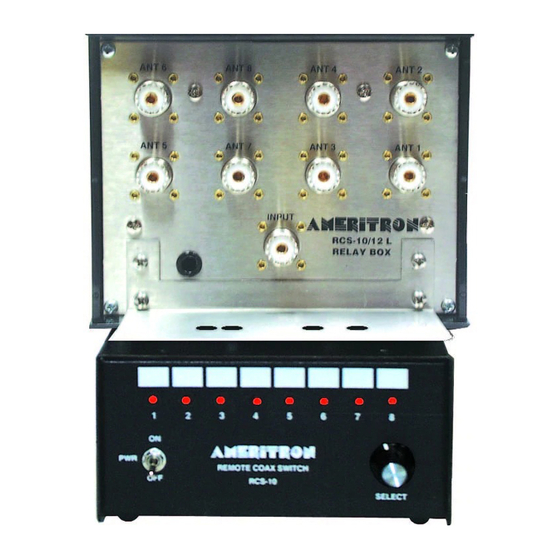AMERITRON RCS-10 Manual de instruções - Página 6
Procurar online ou descarregar pdf Manual de instruções para Interruptor AMERITRON RCS-10. AMERITRON RCS-10 16 páginas. Remotec coax switch

Ameritron RCS-10
The horizontal row is the "through ports"; the vertical row is "unwanted ports":
Ports
1
2
1
X
25.8
2
19.8
X
3
19.8
37
4
30.8
19.5
5
19.4
40.1
6
32.5
18.9
7
35
51
8
46
32.4
Description
The remote relay unit is designed for indoor or outdoor mounting. It has a UV resistant
ABS weather cover and corrosion resistant metal parts. The mounting bracket assembly
is designed to accept masts from 1 inch up to 2-1/4 inch outside diameter, but can also be
attached to flat surfaces.
The remote relay switch section is designed for 50-ohm systems, and operates from dc to
60 MHz with very good performance. The RCS-10 can be used to 150 MHz, but only in
non-critical applications. Examples of non-critical applications are switching antennas for
local repeater or simplex operation. Examples of critical applications where the RCS-10
could cause problems would include long-distance weak-signal work or SWR critical
systems. SWR of the RCS-10 can be as high as 1.8:1 on 150MHz, and port-to-port
isolation can be as low as 19dB.
The RCS-10 relay switch section is normally supplied with high-quality UHF-type
connectors, although N-connector models are available. 16-ampere sealed contactors
easily handle power levels exceeding 1500 watts on frequencies below 60MHz, and over
500 watts at 150MHz. Typical power handling below 30 MHz exceeds 5kW.
IMPORTANT NOTE ABOUT CONNECTORS!
Although type-N connectors improve weather sealing, they will not improve loss or SWR
performance of this switch. Standard UHF connectors have negligible loss, and have
immeasurable affect on system SWR below upper VHF. Type-N connectors may reduce
power-handling capabilities of this switch.
Control signals use a three-wire system (plus ground). The control signals are BCD
encoded. In this system control wires are labeled A, B and C, and operate using an
assigned value of A=1, B=2, and C=4. By using this system, three wires can count from
zero to seven. The relay box selects up to eight antennas using the following scheme:
4
3
4
5
23.7
39
24.1
31.1
24
37.9
X
25.5
38.7
19.4
X
54
38.4
52
X
46
38.8
19.8
19.6
40.2
19.7
32.4
19.1
30.6
Instruction Manual
6
7
8
43.5
42
56
23.5
56
42.4
58
24.3
44.4
37.5
37.3
24.1
25.4
23.3
39.6
X
30.7
23.5
37.4
X
25.2
19.4
19.3
X
